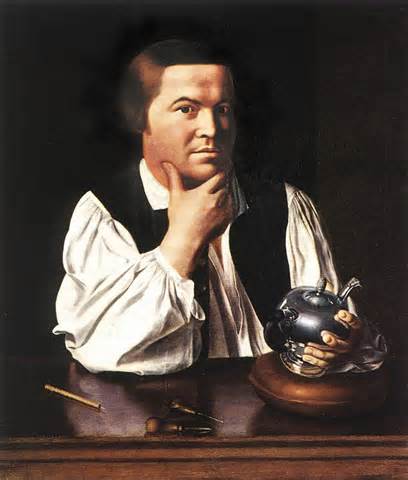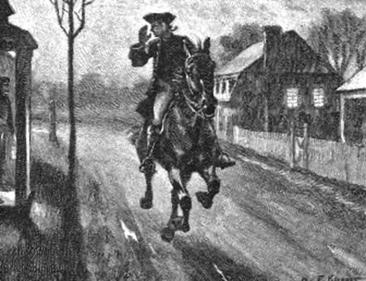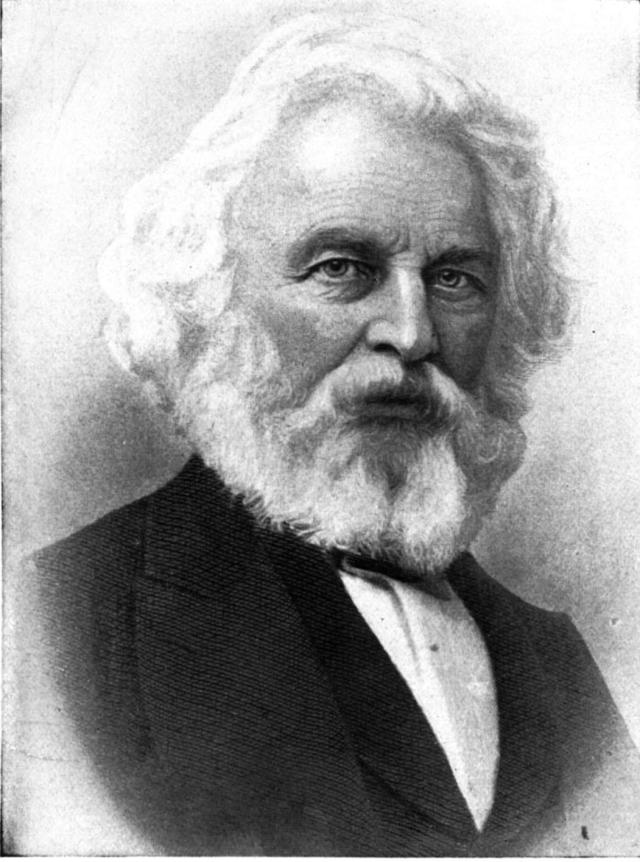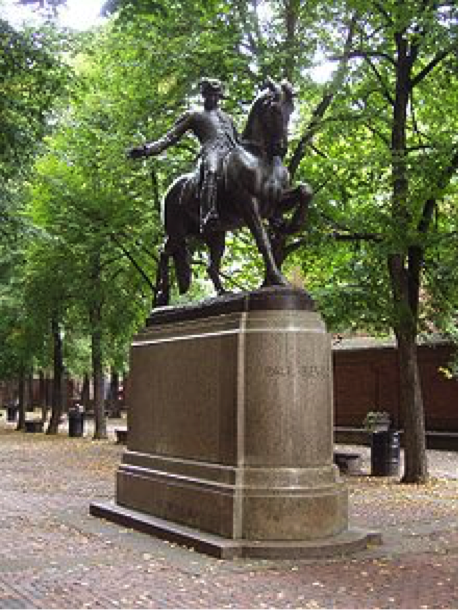
(Radical Activist and silversmith Paul Revere. Portrait by John Singleton Copley)
It is a grand day in Washington, with multiple events happening downtown as disparate as Earth Day (huge concert on the Mall) and the tightly-buttoned IMF/World Bank Spring Meetings.
There have been some anniversaries of momentous events over the last couple weeks. I think associating a particular date with an event on the calendar helps us to imagine it- bring life from dust- by comparing the weather now as it might have been then. The feel of the breeze against skin, that sort of thing.
Actually, anniversaries mean nothing except we like round numbers. Interest in the epic poems of the past has waned for the most part. We are too busy playing “Angry Birds” on our hand-held devices, or increasingly on our wrist computers. I am going to subject you to Henry Wadsworth Longfellow’s epic poem since we have another round number today. It is the 240th anniversary of Paul Revere’s grand adventure, and the outbreak of open warfare in the British North American colonies.
Revere was still alive when Longfellow was a boy, and the poet lived (and died) in Cambridge, so the memories were still fresh.
Paul Revere was an interesting man. He was, by turns, an expert silversmith, father of 16 kids by two wives, early industrialist, soldier and political radical. He was an engraver, propagandist and occasional dentist, too. His greatest contribution to the nation might have been inventing the process to successfully roll copper into sheets for use as anti-fouling sheathing for naval vessels, a technology that is used today to produce Revere Cookware. But of course, Longfellow made him famous for the ride, and that is what we go with.
It certainly beats being remembered for the disastrous 1779 Penobscot Expedition, an amphibious assault conducted by a Colonial 44-ship flotilla with 1,000 Marines and militiamen against British fortifications on the coast of Maine. The Brits had renamed the territory “New Ireland” for the occasion, and the result of three weeks of fighting was one of the biggest victories of the war for the King’s men. It was also the most humiliating defeat the American Navy would suffer until Pearl Harbor.
Paul Revere was a light Colonel in the deployment, commanding a hundred militiamen, but he was exonerated of responsibility in the ensuing investigation, and Longfellow (and history) had pretty much succeeded in forgetting about the whole thing.
Boston is a great town on foot, and I enjoyed living there briefly a couple times. I have visited one of the houses where he lived in Boston, viewed the historic Old North Church and traced the route of part of the ride to Lexington and Concord. It is hard not to imagine men concealing themselves behind the stone walls, and popping off rounds at the Red Coats with their muskets.
Let’s set the scene. Tensions in the Bay Colony were high. In response to the insolence displayed to the King’s lawful direction, troops had been dispatched to the Massachusetts Colony, and residents were afraid the Red Coats might take action to disarm them and arrest their leaders Sam Adams and John Hancock. Between 2100 and 2200 on the night of April 18, 1775, Physician and Sons of Liberty leader Joseph Warren got the “One if by land, two if by sea” signal from the lights placed in the window of the steeple of the Old North Church. He saw two. Warren told Revere and co-conspirator William Dawes that the King’s troops were about to embark in boats from Boston up the Charles River to Cambridge. Disembarking there, they would march to Lexington and Concord.
Warren believed that the munitions stored at the latter village were safe, but that Adams and Hancock had to be warned in Lexington. He dispatched Revere and Dawes to warn them and to alert colonial militias in nearby towns. The ride would trigger the “alarm and muster” system that had been carefully developed months before after the British forces successfully confiscated stores of gunpowder from the radials. This system was an improved version of an old network of widespread notification and fast deployment of local militia forces in times of emergency that dated to the times of strife with local Indians.
Revere started by crossing the Charles River by rowboat, slipping past the British warship HMS Somerset in the process. He landed in Charlestown and rode through the hamlets of Somerville, Medford and Arlington (as we know them now), avoiding a British patrol and shouting the news to each house along the way. The radicals in Charlestown also sent riders to the north. By the end of the night, there were as many as forty riders spreading the alarm in Middlesex County.
According to people who ought to know this, the words that Revere shouted were “The Regulars are coming out!”


Revere got to Lexington around midnight, with Dawes a half hour behind. They conferred by candlelight with Adams and Hancock about the intent of the British troops. The force was estimated at more than five hundred men, and seemed excessive for a mission to arrest just two men, disobedient rabble-rousers though they might be. Perhaps instead they intended to seize military supplies stock-piled in Concord after all. The word needed to get there. Dawes and Revere mounted up and were joined by Doctor Samuel Prescott, who happened to be in Lexington “returning from a lady friend’s house at the awkward hour” of 0100. They rode toward Concord, but were stopped by a patrol of the King’s men at the village of Lincoln.
Prescott jumped his steed over a fence and got away to spread the warning. Dawes eluded the soldiers but was dismounted and failed to complete the ride. Revere was busted, and his mount was seized. The British forced him to accompany them on foot as they advanced, but released him when shots were heard ahead.
The militiamen were waiting. In addition to express riders fanning out across the County, bells, drums, alarm guns, bonfires, and trumpets were used for rapid communication from town to town, notifying the rebels in dozens of eastern Massachusetts villages that they should muster their militias to respond to the body of British troops. The system was so effective that villages 25 miles from Cambridge were aware of what was coming before the Regulars could even disembark from their boats.
The alarm raised by the three riders successfully allowed the militia to confront the British troops in Concord, and then harry them all the way back to Boston. North America was never going to be quite the same ever again.
Paul Revere’s Ride
Henry Wadsworth Longfellow

(H. W. Longfellow, 1807-1882)
Listen my children and you shall hear
Of the midnight ride of Paul Revere,
On the eighteenth of April, in Seventy-five;
Hardly a man is now alive
Who remembers that famous day and year.
He said to his friend, “If the British march
By land or sea from the town to-night,
Hang a lantern aloft in the belfry arch
Of the North Church tower as a signal light,–
One if by land, and two if by sea;
And I on the opposite shore will be,
Ready to ride and spread the alarm
Through every Middlesex village and farm,
For the country folk to be up and to arm.”
Then he said “Good-night!” and with muffled oar
Silently rowed to the Charlestown shore,
Just as the moon rose over the bay,
Where swinging wide at her moorings lay
The Somerset, British man-of-war;
A phantom ship, with each mast and spar
Across the moon like a prison bar,
And a huge black hulk, that was magnified
By its own reflection in the tide.
Meanwhile, his friend through alley and street
Wanders and watches, with eager ears,
Till in the silence around him he hears
The muster of men at the barrack door,
The sound of arms, and the tramp of feet,
And the measured tread of the grenadiers,
Marching down to their boats on the shore.
Then he climbed the tower of the Old North Church,
By the wooden stairs, with stealthy tread,
To the belfry chamber overhead,
And startled the pigeons from their perch
On the sombre rafters, that round him made
Masses and moving shapes of shade,–
By the trembling ladder, steep and tall,
To the highest window in the wall,
Where he paused to listen and look down
A moment on the roofs of the town
And the moonlight flowing over all.
Beneath, in the churchyard, lay the dead,
In their night encampment on the hill,
Wrapped in silence so deep and still
That he could hear, like a sentinel’s tread,
The watchful night-wind, as it went
Creeping along from tent to tent,
And seeming to whisper, “All is well!”
A moment only he feels the spell
Of the place and the hour, and the secret dread
Of the lonely belfry and the dead;
For suddenly all his thoughts are bent
On a shadowy something far away,
Where the river widens to meet the bay,–
A line of black that bends and floats
On the rising tide like a bridge of boats.
Meanwhile, impatient to mount and ride,
Booted and spurred, with a heavy stride
On the opposite shore walked Paul Revere.
Now he patted his horse’s side,
Now he gazed at the landscape far and near,
Then, impetuous, stamped the earth,
And turned and tightened his saddle girth;
But mostly he watched with eager search
The belfry tower of the Old North Church,
As it rose above the graves on the hill,
Lonely and spectral and sombre and still.
And lo! as he looks, on the belfry’s height
A glimmer, and then a gleam of light!
He springs to the saddle, the bridle he turns,
But lingers and gazes, till full on his sight
A second lamp in the belfry burns.
A hurry of hoofs in a village street,
A shape in the moonlight, a bulk in the dark,
And beneath, from the pebbles, in passing, a spark
Struck out by a steed flying fearless and fleet;
That was all! And yet, through the gloom and the light,
The fate of a nation was riding that night;
And the spark struck out by that steed, in his flight,
Kindled the land into flame with its heat.
He has left the village and mounted the steep,
And beneath him, tranquil and broad and deep,
Is the Mystic, meeting the ocean tides;
And under the alders that skirt its edge,
Now soft on the sand, now loud on the ledge,
Is heard the tramp of his steed as he rides.
It was twelve by the village clock
When he crossed the bridge into Medford town.
He heard the crowing of the cock,
And the barking of the farmer’s dog,
And felt the damp of the river fog,
That rises after the sun goes down.
It was one by the village clock,
When he galloped into Lexington.
He saw the gilded weathercock
Swim in the moonlight as he passed,
And the meeting-house windows, black and bare,
Gaze at him with a spectral glare,
As if they already stood aghast
At the bloody work they would look upon.
It was two by the village clock,
When he came to the bridge in Concord town.
He heard the bleating of the flock,
And the twitter of birds among the trees,
And felt the breath of the morning breeze
Blowing over the meadow brown.
And one was safe and asleep in his bed
Who at the bridge would be first to fall,
Who that day would be lying dead,
Pierced by a British musket ball.
You know the rest. In the books you have read
How the British Regulars fired and fled,—
How the farmers gave them ball for ball,
From behind each fence and farmyard wall,
Chasing the redcoats down the lane,
Then crossing the fields to emerge again
Under the trees at the turn of the road,
And only pausing to fire and load.
So through the night rode Paul Revere;
And so through the night went his cry of alarm
To every Middlesex village and farm,—
A cry of defiance, and not of fear,
A voice in the darkness, a knock at the door,
And a word that shall echo for evermore!
For, borne on the night-wind of the Past,
Through all our history, to the last,
In the hour of darkness and peril and need,
The people will waken and listen to hear
The hurrying hoof-beats of that steed,
And the midnight message of Paul Revere

(This Paul Revere Statue in Boston’s historic North End. Cast by Cyrus Dallin, it was unveiled on Prince Spaghetti Day September 22, 1940. Just kidding, but I best someone was boiling noodles not far away. Image Wikipedia).
Copyright 2015 Vic Socotra
Poem by Henry Wadsworth Longfellow- rights reserved.
www.vicsocotra.com
Twitter: @jayare303
